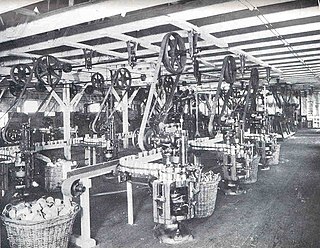
Wayne County is a county in the U.S. state of New York. As of the 2020 Census, the population was 91,283. The county seat is Lyons. The name honors General Anthony Wayne, an American Revolutionary War hero and American statesman.

Havre de Grace, abbreviated HdG, is a city in Harford County, Maryland. It is situated at the mouth of the Susquehanna River and the head of Chesapeake Bay. It is named after the port city of Le Havre, France, which in full was once Le Havre de Grâce.

Arcadia is a town in Wayne County, New York, United States. The population was 14,244 at the 2010 census.

Newark is a village in Wayne County, New York, United States, 35 miles (56 km) south east of Rochester and 48 miles (77 km) west of Syracuse. The population was 9,017 at the 2020 census. The Village of Newark is in the south part of the Town of Arcadia and is in the south of Wayne County. It is the most populous community in Wayne County.

Newark is a city in and the county seat of Licking County, Ohio, United States, located 40 miles (64 km) east of Columbus at the junction of the forks of the Licking River. The population was 49,934 at the 2020 census, making it the 18th-largest city in Ohio. It is part of the Columbus metropolitan area.

Canning is a method of food preservation in which food is processed and sealed in an airtight container. Canning provides a shelf life that typically ranges from one to five years, although under specific circumstances, it can be much longer. A freeze-dried canned product, such as canned dried lentils, could last as long as 30 years in an edible state.

The Southern Tier is a geographic subregion of the broader Upstate region of New York State, geographically situated along or very near the state border with Pennsylvania. Definitions of the region vary widely, but generally encompass counties surrounding the Binghamton and Elmira-Corning metropolitan areas. This region is adjacent to the Northern Tier of Pennsylvania, and both these regions together are known as the Twin Tiers.
The Lake Shore and Michigan Southern Railway, established in 1833 and sometimes referred to as the Lake Shore, was a major part of the New York Central Railroad's Water Level Route from Buffalo, New York, to Chicago, Illinois, primarily along the south shore of Lake Erie and across northern Indiana. The line's trackage remains a major rail transportation corridor used by Amtrak passenger trains and several freight lines; in 1998, its ownership was split at Cleveland between CSX Transportation to the east and Norfolk Southern Railway in the west.

For the purposes of this article, the Jersey City area extends North to Edgewater, South to Bayonne and includes Kearny Junction and Harrison but not Newark. Many routes east of Newark are listed here.

New York State Route 88 (NY 88) is a north–south state highway in the Finger Lakes region of New York in the United States. It extends for 20.62 miles (33.18 km) from an intersection with NY 96 in the Ontario County village of Phelps to a junction with NY 104 in the Wayne County town of Sodus. In between, NY 88 passes through the Village of Newark, where it intersects NY 31 and crosses over the Erie Canal. NY 88 originally extended south to the city of Canandaigua when it was assigned as part of the 1930 renumbering of state highways in New York. It was truncated to its current length in August 1972. According to the New York State Department of Transportation (NYSDOT), the NY 382 designation is reserved for the NY 88 alignment. No timetable exists for the redesignation of NY 88 to NY 382.

The Alaska Packers' Association (APA) was a San Francisco based manufacturer of Alaska canned salmon founded in 1891 and sold in 1982. As the largest salmon packer in Alaska, the member canneries of APA were active in local affairs, and had considerable political influence. The Alaska Packers' Association is best known for operating the "Star Fleet," the last fleet of commercial sailing vessels on the West Coast of North America, as late as 1927.

Wales Island is an island on the North Coast of British Columbia, Canada, situated east of the Dixon Entrance at the entrance to Portland Inlet.


Canned or tinned fish are food fish which have been processed, sealed in an airtight container such as a sealed tin can, and subjected to heat. Canning is a method of preserving food, and provides a typical shelf life ranging from one to five years. They are usually opened via a can opener, but sometimes have a pull-tab so that they can be opened by hand. In the past it was common for many cans to have a key that would be turned to peel the lid of the tin off; most predominately sardines, among others.

Unity Pond (Lake Winnecook) is the largest lake in Waldo County, Maine. It is within the towns of Unity, Burnham, and Troy. The main tributaries are Meadow Brook, Bithers Brook, and Carlton Stream. The sole outflow is Twenty-Five Mile Stream, via a wetlands to the southwest of the lake, which in turn feeds into the Sebasticook River. The lake is surrounded by almost 300 residences, of which slightly more than half are seasonal. It is also used for boating, fishing, camping, and swimming. Kanokolus Beach on the southwest shore and Burnham Town Beach are both open to the public.

Ganargua Creek, also known as Mud Creek, is a main tributary which feeds the Erie Canal and Clyde River in Wayne County, New York, United States. The creek begins just east of the village of Victor in nearby Ontario County and meanders approximately 34 miles from west to east before emptying into the Erie Canal in the hamlet of Lyons. Ganargua Creek is actually split into two sections as it runs concurrent with the Erie Canal for about 3 miles near the village of Palmyra. Numerous tributaries feed Ganargua Creek along its route.

Clover Leaf Seafoods Company is the leading marketer of canned seafood in Canada. Headquartered in Markham, Ontario, it sells canned, shelf-stable, and frozen goods under the Clover Leaf and Brunswick brands. The company's products include tuna, salmon, oysters, mussels, clams, shrimp, crab, lobster and sardines. Clover Leaf Seafoods, a wholly owned subsidiary of Connors Bros., L.P., markets Bumble Bee (USA) Seafoods.
Sacramento, California, United States, has been an important location in the history of canning thanks to its situation on the intersection of major transportation routes and proximity to large fertile growing areas. Sacramento’s canning industry has prepared a large variety of agricultural products, but is best known for canned tomatoes, earning Sacramento the nickname, "The Big Tomato."
The B&M Baked Beans factory is an historic cannery building in Portland, Maine, USA. The building was constructed in 1913 in the East Deering neighborhood by the Burnham & Morrill Company. Baked beans were produced in the building until 2021. The building is a prominent landmark highly visible from Interstate 295. It is located at 1 Beanpot Circle.